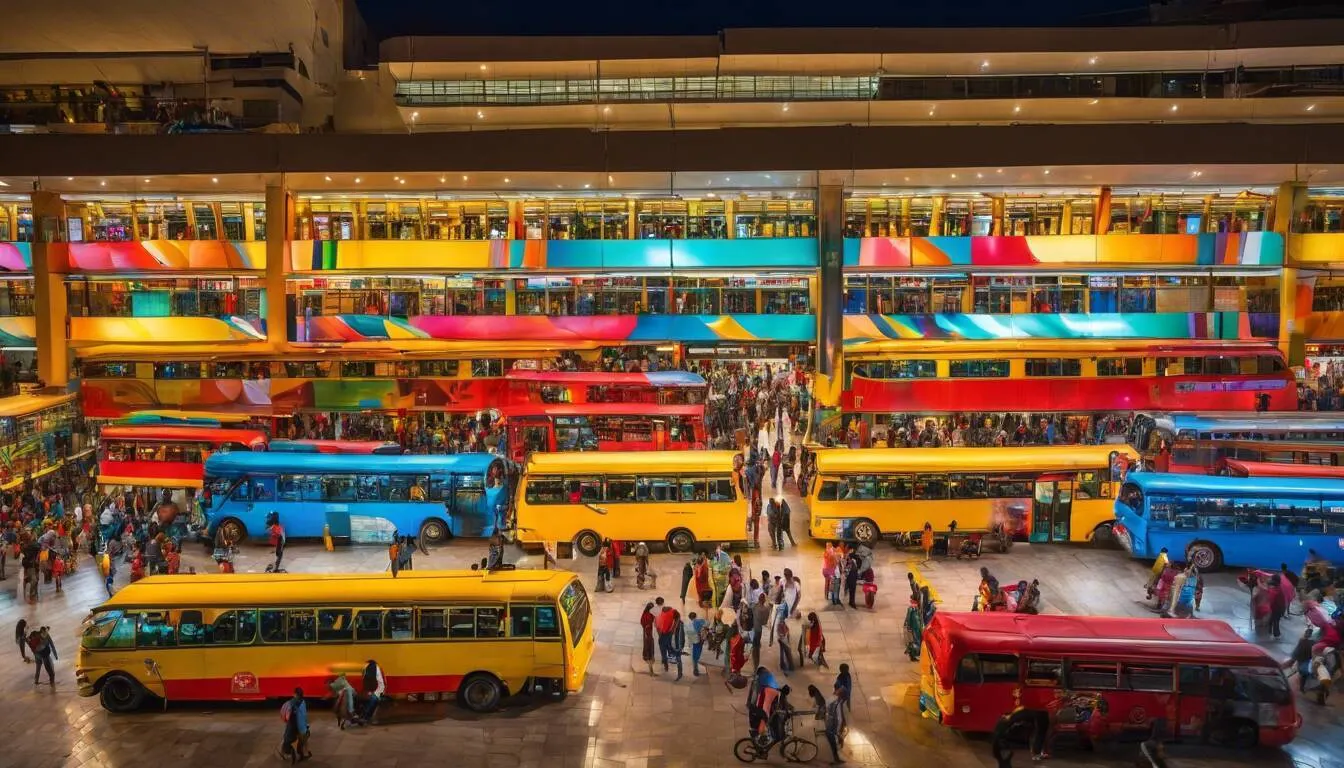Dive into the heartbeat of Mexico by navigating its vast landscapes on wheels! Our ultimate guide to Mexican bus lines will revolutionize your travel, replacing uncertainties and worries with clear insights. Packed with insider tips about routes, schedules, fares, and everything in between, we’ll be flipping your solo travel worries into a lifetime thirst for road adventures in the land of colors. Strap in as we embark on this vivid journey, mixing local flavors and breathtaking views with the rhythm of some of Mexico’s most reliable road warriors.
Mexican bus companies can be categorized into three main classes: executive, first class, and second class. Some notable bus companies include ETN (luxury buses primarily serving central and northern Mexico), ADO (mainly in the Yucatan Peninsula, southern Mexico, and parts of central Mexico), and Primera Plus (routes through central Mexico and along the Pacific Coast). These companies offer comfortable buses with amenities such as reclining seats, air conditioning, bathrooms, Wi-Fi (availability may vary), and various routes to explore different parts of Mexico. It’s recommended to compare different bus company options before choosing one for your desired route.

Table of Contents
Overview of Top Mexican Bus Lines
Mexico boasts an extensive network of bus lines to cater to the needs of locals and tourists alike. Whether you’re looking for comfortable executive coaches or budget-friendly second-class buses, Mexico’s transport options have got you covered. Some of the top bus lines operating in Mexico include ADO, ETN, Primera Plus, and Flecha Amarilla, among others. In this guide, we’ll give you a comprehensive overview of each.
- As of 2023, Mexican transportation watchdog report stated that ETN, a luxury bus company primarily operating in central and northern Mexico, serves approximately 1 million riders annually.
- A survey by the Transport Regulatory Agency in Mexico reported in 2023 that close to 70% of domestic travelers prefer first class buses like ADO due to their reach across Yucatan Peninsula, southern Mexico, and parts of central Mexico.
- The same survey stated that budget-friendly options like Primera Plus, with routes traversing central and Pacific coast regions of Mexico, cater to nearly 60% of the cost-conscious market segment in inter-city travel.
- Mexico has a well-developed and diverse bus transportation system, with a wide range of options to suit different budgets and preferences. Top bus lines in the country include ADO, ETN, Primera Plus, and Flecha Amarilla. Whether you’re looking for luxury executive coaches or more affordable second-class buses, Mexico’s bus network provides reliable and convenient transportation for both locals and tourists.
Executive vs First Class vs Second Class
Before examining the specific aspects of individual Mexican bus companies, it’s wise to have a clear understanding of what each class entails. Executive class is the most luxurious and often features amenities such as reclining seats, blankets, pillows, onboard entertainment systems, air conditioning, and even bathrooms. These services tend to be more expensive but are worth it if you’re looking for a comfortable journey.
Next up is first-class; while not as luxurious as the executive class, they still offer ample legroom and reclining seats with reasonable amenities at a more affordable price than executive. Some reputable first-class providers include Futura and Costa Line.
Lastly, there is second-class which is the most economical option; less glamorous than first-class or executive but provides all the basic necessities for travelling. They are significantly cheaper than their counterparts in exchange for fewer luxuries and comfort.
While each class has its pros and cons depending on travel preferences and budgets; choosing between these classes should depend on your priorities; saving money over comfort.
See Related: Bringing Dogs on MTA Buses: Guidelines and Regulations
Guide to Bus Routes and Schedules
Mexico is known for having a vast bus network that is available all across the country, making it an accessible destination for travelers on a budget. It’s crucial to have a more in-depth understanding of bus routes and schedules when planning your itinerary. So what exactly do you need to know?
First, it’s essential to research which bus company you’ll use. As previously mentioned, some companies offer better amenities while others cater towards more affordable options. Two popular companies that stand out in terms of offerings, are ADO and ETN.
Once you’ve researched your preferred bus company, it’s time to take note of the key locations you will be visiting and their designated terminals. These terminals are usually located within busy tourist destinations like Cancun or Mexico City. From there, the route optIons are endless.
Popular Destinations and Timings
Understanding travel times based on specific locations is essential when planning your trip around Mexico. Here are some popular destinations serviced by several bus companies:
- Cancún: ADO and ETN buses run daily from both Mexico City (20 hours) and Merida (6 hours).
- Playa del Carmen: Buses run hourly from Cancun’s ADO terminal.
- México City: First class companies such as ADO (flying from Terminal 1) offer express services with minimal stops between key cities.
- Puerto Vallarta: Many first-class buses operate here, including Primera Plus and ETN.
- Guadalajara: This is a busy route that includes different operators servicing multiple stops all along the way.
Keep in mind that fares vary depending on the operator – luxury options will be decidedly pricier than economy or second class ones. The timing of your trip can also be crucial in determining prices; peak season fares could cost significantly higher than if traveling during the off-season.
If your aim is to travel to Cancun from Mexico City, ADO has a direct bus service in the afternoon and night, with the journey taking between twenty and twenty-two hours. If you’re looking for a quicker route, ETN has an express service that takes half the time though it largely depends on your schedule preferences.
Understanding Bus fares in Mexico
Mexico’s vast network of bus lines is designed to cater to travelers on different budgets. However, understanding bus fares can be confusing for first-time visitors. Many factors determine bus ticket prices, including distance covered, time of travel, amenities offered and the type of bus. In most cases, buses traveling longer distances cost more than those covering shorter routes.
It’s also essential to note that Mexican bus companies operate under regulated tariffs governed by the government’s ministry of transportation. Therefore, don’t expect significant variations in price across companies serving similar routes.
Comparing Costs Across Different Companies
Aside from a few regulated differences, there are often price variations between Mexican bus lines based on their available services and amenities. Generally speaking, luxury buses or Class A later model coaches run at higher rates than older Class B or regular coaches.
For example, a journey from Cancun to Tulum (approximately 118 kilometers) can cost as low as $6 USD on a Hop-On / Hop-Off Pollo Feliz yet more than $30 USD if taken on a luxury coach like the ADO Platinum service.
Some popular bus lines might include extra charges before departure such as insurance fees associated with departures from larger stations or refundable PET bottles deposit fees. As such, it’s essential to compare different options across various websites or portals and read reviews before settling for a particular bus line. Also, consider booking in advance when planning journeys between top destinations to enjoy reduced prices.
Once you have grasped these basics about Mexican bus fares, you can then proceed to understand other critical aspects when travelling by Mexican buses.
Tips for Travelling with Mexican Buses
Mexican buses are an affordable and convenient way to travel between cities and towns throughout the country. However, like any method of transportation, there are tips and tricks that can enhance your overall experience.
Firstly, it’s crucial to plan ahead and book your tickets in advance to secure a seat on your desired route. Consider utilizing bus company apps or websites such as ADO or Primera Plus for easy online payment options. If booking in person instead, make sure to bring valid identification.
Pack light with only essential items since storage space can be limited, especially on second-class buses. It’s also recommended to bring snacks and drinks for longer journeys since stops may be infrequent, although most long-distance buses provide onboard refreshments for purchase.
Another top tip is to dress comfortably as bus temperatures can vary depending on the time of day and region visited. For example, northern Mexican states tend to be hot during the day but cooler at night, while southern areas may experience heat and humidity year-round.
You might also want to consider bringing earplugs or headphones to drown out potential noise distractions when trying to get some rest.
Mexican society is known for its warmth and friendliness towards foreigners, but it’s still advisable to exercise caution when traveling and keep valuables safe. Keep copies of important documents with you at all times and stow away valuable items such as laptops or cameras securely in your carry-on bag.
Having delved into some general tips for traveling on Mexican buses let’s turn our attention to what riders can expect from the amenities offered and cultural nuances when using this mode of transportation.
Amenities, Safety, and Cultural Nuances
Mexican buses offer varying levels of amenities depending on the class type you choose. Executive buses will generally include reclining seats, air conditioning, individual TV screens, WiFi functionality (sometimes unreliable) and bathrooms. These buses are more expensive but worth it for longer journeys, especially given the added luxuries.
First-class buses provide an affordable middle option with amenities such as air conditioning, reclining seats, bathrooms, and other basic perks. While still convenient, WiFi may not be reliable on this class of bus.
Second-class buses are a budget-friendly option, although they might not offer the same level of comfort as their higher-end counterparts. They are ideal for shorter distances or those traveling between smaller towns where first-class or executive options may not be readily available.
It’s important to note that while services and facilities between bus companies can vary considerably, there is a noticeable emphasis on extra seating space between passengers in Mexico compared to other countries.
Additionally, Mexicans tend to be social beings and may strike up conversations with fellow passengers during pit stops or longer rides. A smile and friendly disposition can go a long way in forging new connections and getting local tips on places to visit or eat.
When entering or exiting the bus at rest stops or final destinations, passengers should observe certain cultural norms such as maintaining queue order, holding doors open for others when entering or exiting, and greeting drivers or station clerks politely.
Think of it like navigating different cultures when travelling abroad: showing respect for cultural nuances will help you make meaningful connections and lasting memories.
